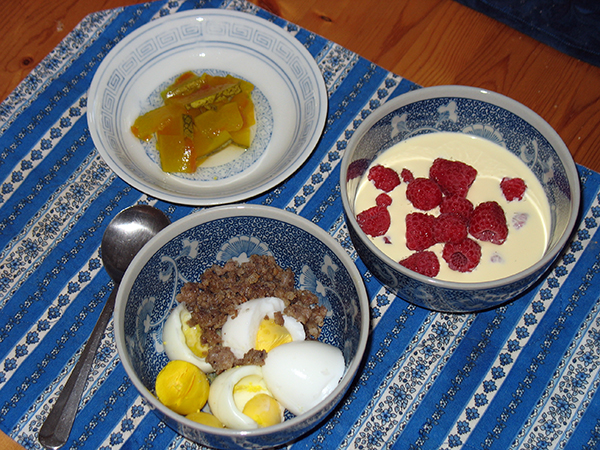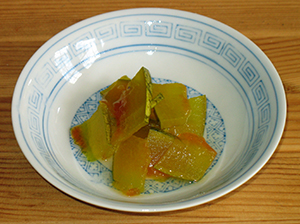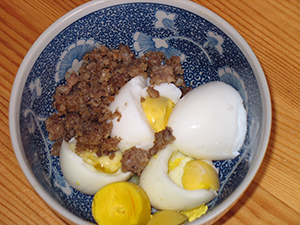I like sharing what I’ve learned about nutrition in the last decade. Many of my old ideas about healthy eating have been overturned, and I figure that others may be in the same boat I was: following governmental recommendations that are incorrect. So I try to spread the word about these politically correct, but inaccurate myths.
Most of my nutrition posts are some combination of general information plus recipes.
But last fall, I had an idea for another way to share about food. Menus!
Not fancy, cookbooky menus that I (for one) plan to prepare and then never do. No. Menus of what I actually eat.
So this is the first of my menu posts. Breakfast.

What do I eat for breakfast? It’s pretty standard. I like variation in my lunches. And I want even more variation for my dinners. But, for breakfast, I am content to eat the same thing, day after day. Good thing! If I had to wrack my brain for multiple breakfast ideas, I’d…I don’t know what I’d do, actually. It would be a pain!
So here’s my breakfast menu:
• a lacto-fermented food
• berries and cream
• boiled eggs and ground sausage
In the photo above, the lacto-fermented food is watermelon pickles, and the berries are raspberries. Those specifics do change as the seasons pass and as I finish various jars of lacto-ferments. Sauerkraut, beet kvass, strawberries, blueberries, etc. have been known to make their appearance in my first meal of the day.
So that’s what I eat for breakfast. But why do I eat these items?
Ah! You knew I’d get to the why of it, didn’t you? 😀
 Let’s tackle the easiest dish first: the lacto-fermented one.
Let’s tackle the easiest dish first: the lacto-fermented one.
Lacto-fermented foods have all those beautiful lactobacilli and enzymes in them. The enzymes mean I digest my food more thoroughly and easily. My body need not make as many of its own enzymes from scratch and I absorb more of the vitamins and minerals present in the food. Plus there are more vitamins and minerals in lacto-fermented food than in merely raw or cooked food.
Serious students of nutrition speculate that the centenarians who once were so numerous in the mountain communities of Russia’s Caucasus owed their healthy longevity, in part, to the many lacto-fermented foods they ate with every meal. I’d certainly like some of that healthy longevity! Plus, lacto-fermented foods taste good!
If you’d like to learn more about lacto-fermented foods, read Amazing Lactobacilli (an earlier post on my blog).
What about the berries and cream?
 The berries are also easy to explain. Article after article appears in health newsletters, nutrition blogs, and the health section of newspapers explaining that the phytochemicals in berries – the natural compounds that give them their deep color – help our bodies fight cancer, stroke, and cardiovascular disease. Sign me up!
The berries are also easy to explain. Article after article appears in health newsletters, nutrition blogs, and the health section of newspapers explaining that the phytochemicals in berries – the natural compounds that give them their deep color – help our bodies fight cancer, stroke, and cardiovascular disease. Sign me up!
The cream is trickier to explain. Our current culture is convinced that saturated fat is bad for us. So convinced that we’re loading up on polyunsaturated fat to a degree that our ancestors never did. And for which our bodies are not designed. Saturated fats are a critical component of our brains and the myelin sheath that covers our nerves. It’s also a critical component of the hormones and enzymes that carry messages throughout the human body and do the brunt of the work that keeps our bodies functioning.
Bottom line: fat does not cause cardiovascular disease. The weight gain and inflammation resulting from heavy grain and carb consumption causes cardiovascular disease. Saturated fats are essential to good health. Thus, I eat cream from grass-fed cows!
That’s a pretty controversial statement these days, so I urge you not to take my word for it. (Or anyone else’s.) Read up about the topic. Read books that challenge your beliefs. Read Eat Fat, Lose Fat by Sally Fallon and Good Calories, Bad Calories by Gary Taubes. I’ve blogged about both these books in Butter and Cream and Coconut, Oh My! and Test first, then conclude! Then decide for yourself.
So what about eggs with butter and sausage?
 Before the egg scare back in the 1970’s, eggs were regarded as close to the parfect food because they contain amino acids (the building block of protein) in exactly the proportion that the human body needs to build muscle and other tissues. Then scientists realized that eggs have a lot of cholesterol. Oh, no! Cholesterol is found in arterial plaque! It must be bad!
Before the egg scare back in the 1970’s, eggs were regarded as close to the parfect food because they contain amino acids (the building block of protein) in exactly the proportion that the human body needs to build muscle and other tissues. Then scientists realized that eggs have a lot of cholesterol. Oh, no! Cholesterol is found in arterial plaque! It must be bad!
Well, no. It took a while, but eventually the researchers realized that unless you have a particular unusual syndrome, cholesterol that you eat does not become plaque in your arteries. Instead, it’s an essential ingredient for the cell walls of the cells that make up your body, as well as a building block for critical hormones, bile acids, and vitamin D. In other words, we need that cholesterol! And the protein profile is close to perfect. Time to rehabilitate the egg.
For the butter, my notes on cream above apply.
And the sausage?
Our human bodies assemble and use nearly 50,000 proteins to make our organs, nerves, muscles and other tissues. Plus enzymes and antibodies are formed of proteins. Proteins are essential to life. And animal protein – meat and eggs – is our only source of complete protein.
 Our hunter gatherer ancestors ate a diet largely composed of meat and fat. Vegetables, fruits, seeds, and nuts were additions to their diet, not the bulk of it. They had excellent bone structure, heavy musculature, and teeth unmarred by any cavities. They were healthy.
Our hunter gatherer ancestors ate a diet largely composed of meat and fat. Vegetables, fruits, seeds, and nuts were additions to their diet, not the bulk of it. They had excellent bone structure, heavy musculature, and teeth unmarred by any cavities. They were healthy.
Looking at more modern populations, the Russians of the Caucasus again show up as long-lived people eating lots of fatty meats and whole milk foods. In studies of Soviet Georgia, those who ate the most meat and fat lived the longest. The denizens of Vilacabamba, Ecuador – also famous for longevity – consume whole milk and fatty pork. And the Masai of the 1930’s – with a diet of meat, milk, and blood – were nearly disease-free.
With meat, we also get back to fats. Yes, the protein is essential, but the fat is equally important. In order to assimilate vitamins A, D, E, K and certain minerals – calcium, iron, zinc, copper, and magnesium – we need fat.
For more about the benefits of meat, read Pasture Perfect. I’ve blogged about this book as well in Grass Green. 😀
One cool bit of trivia about pork: the fat in pork is 45% monounsaturated fat, 11% polyunsaturated fat, and 39% saturated fat. I believe saturated fat to be good for me, but there’s not as much of it in bacon as you might think!
And there you have it: the full rationale behind my breakfast. One more extra benefit: I don’t get hungry for 6 hours after eating it.
For your convenience, I’ll list the links I mentioned in the body of this post:
Amazing Lactobacilli
Butter and Cream and Coconut, Oh My!
Test first, then conclude!
Grass Green
For a dinner menu:
Arugula Beef
